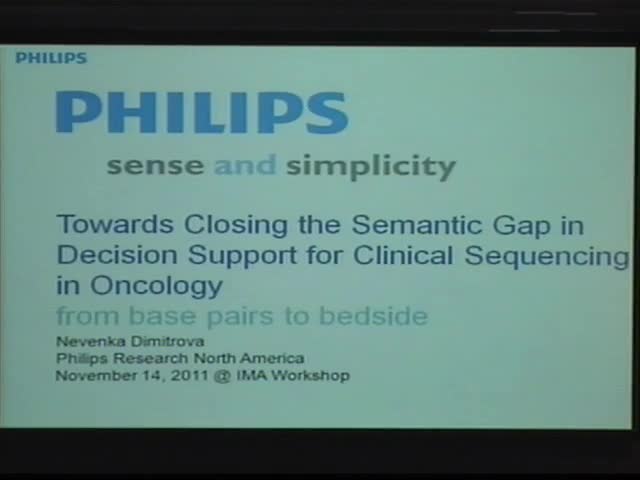Towards Closing the Semantic Gap in Decision Support for Clinical Sequencing in Oncology
Presenter
November 14, 2011
Keywords:
- DNA
MSC:
- 92D20
Abstract
Within only a decade since the first draft of the human genome, we’ve witness astonishing pace of development of technologies for high throughput molecular profiling that probe various aspects of genome biology and its relationship to tumorigenesis and cancer treatment. There have been giant steps towards cataloging massive amounts of data and providing fairly good annotation information. However, computational methods that tried to tease out the relationship between the genotype and its functional readout - in normal and cancer states – revealed a semantic gap that is yet to be bridged. Narrowing this gap is essential in order to develop meaningful clinical decision support technologies.
In addition to imaging modalities which give the gross tissue level properties, crucial decisions in the context of oncology therapy selection require molecular level information that are increasingly captured by the emerging sequencing modalities. We undertook part in multiple studies aiming to understand the tumor heterogeneity and response to chemotherapy. Our efforts span several complementary modalities. In this talk I will provide several examples from our recent high throughput genomic studies:
1. DNA Sequencing: Assembly and downstream analysis of genomic data from normal individuals to understand and establish variation within normal individuals at the single nucleotide and structural level as well as the functional impact of these variations.
2. RNA Sequencing, CNV and DNA methylation: analysis in the context of chemo- and biological therapy response in breast and ovarian cancer.
3. Integration into a computational framework that combines genome-wide DNA methylation, gene expression and copy number variation data in a comprehensive fashion with the aim of finding mechanistic associations as well as signatures indicative of therapy resistance.
Our goal is to include these modalities in a Comprehensive Clinical Decision Support system where we need to integrate sequencing with imaging, pathology and other clinical data.
